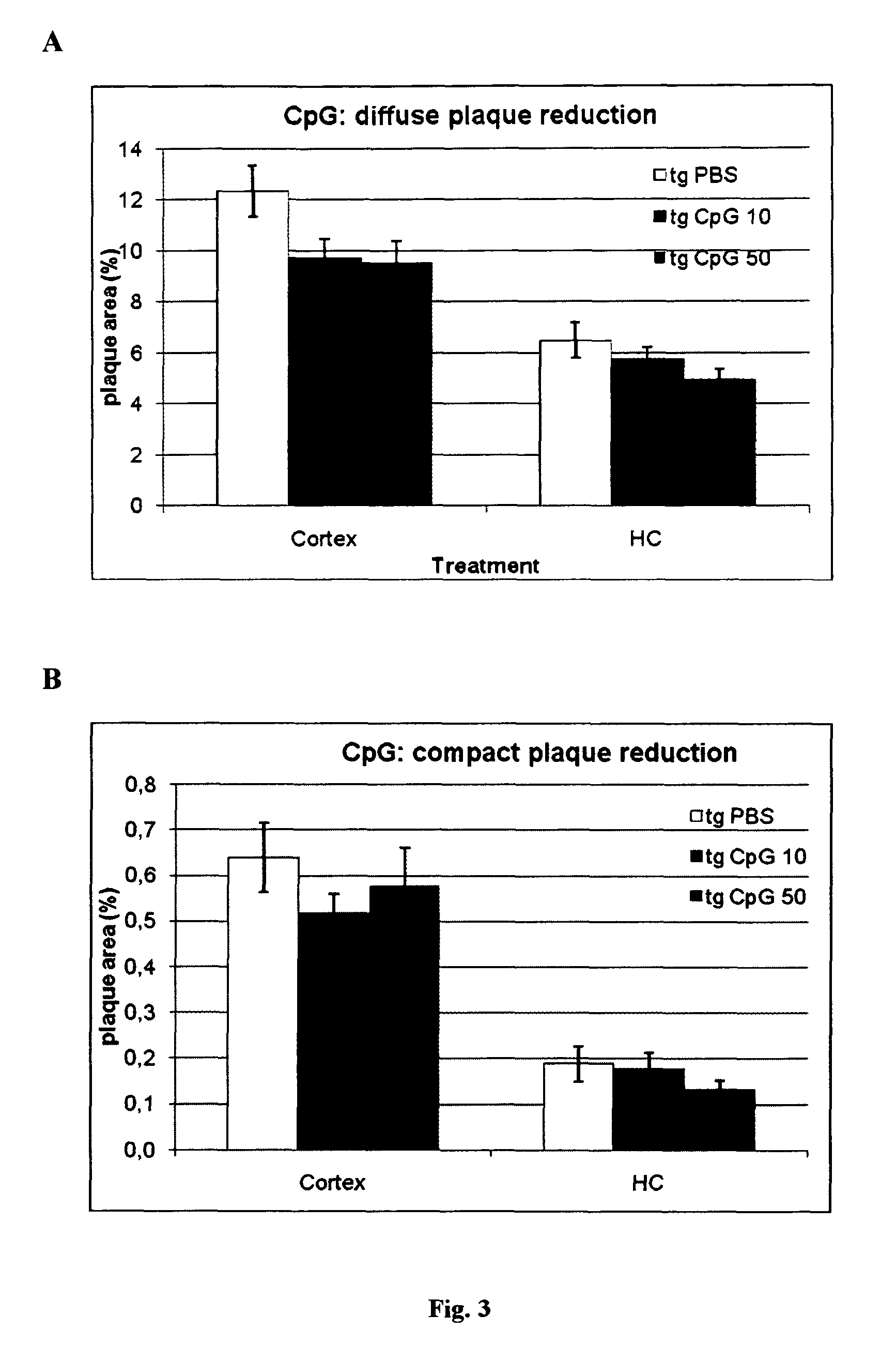Method of providing patient specific immune response in amyloidoses and protein aggregation disorders
a technology of which is applied in the field of providing patient specific immune response in amyloidoses and protein aggregation disorders, can solve the problems of no known effective treatment for preventing, delaying, stopping, or reversing the progression of alzheimer's disease, and reducing the number of patients. , to achieve the effect of enhancing naturally occurring immune responses and favoring selective antibody responses
- Summary
- Abstract
- Description
- Claims
- Application Information
AI Technical Summary
Benefits of technology
Problems solved by technology
Method used
Image
Examples
example 1
Induction of Elevated Titers of Anti-Beta-Amyloid-Plaque Antibodies Concomitant with Reduced Plaque Load in APP Transgenic Mice
[0104]The hypothesis underlying the present invention is confirmed by applying CpG-motifs or SIMRA compounds to immunocompetent amyloid precursor protein transgenic mice with low baseline-levels of auto-antibodies against the human Abeta peptide. In a preferred embodiment of the present invention, the transgenic animal is a mouse harboring a transgene encoding amyloid precursor protein (APP) consisting of the arctic mutation (G693G) and the Swedish mutation (KM670 / 671NL), under the control of the prion protein promoter (PrP) named arcAbeta mouse (Knobloch et al., Neurobiol. Aging Jul. 28 (2006). Aged arcAbeta mice are treated with a single or multiple subcutaneous injections of 0.2 to 20 mg / kg body weight of completely phosphorothioate-modified CpG-oligodeoxyribonucleotide 1826 which is assumed to be a kind of equivalent to the human TLR-9 agonist CpG 7909 (...
example 2
CpG Treatment Improves Behavior in Transgenic Mouse Models of Alzheimer's Disease
[0105]In the Y-maze, a reduced number of arm entries was observed for the PBS treated transgenic APPsweArc mice compared to both groups of wild type littermates analyzed (FIG. 1a). Treatment with either 10 or 50 μg of CpG resulted in an increased number of arm entries indicating a higher level of exploratory activity. Similarly, the percentage of alternations was reduced in PBS treated APPsweArc mice compared to both wild type groups indicating impaired working memory (FIG. 1b). In contrast, APPsweArc mice treated with either dose of CpG performed similar to wild type mice, suggesting that the CpG treatment improved cognitive function.
[0106]In the RAWM experiments average time and errors to reach the platform was analyzed for blocks 3-5 of day 4. PBS-treated APPsweArc mice exhibit increased time (FIG. 2a) and error rate (FIG. 2b), respectively, compared to both wt groups. Treatment with either 10 μg or ...
example 3
CpG Treatment Reduces Total Brain Aβ Plaque Load and Compact Congophilic Amyloid Deposits
[0107]Total Aβ immunohistochemistry using a polyclonal anti-Aβ antibody revealed extensive deposition of Aβ plaques in the cortex and hippocampus (FIG. 3a) of PBS treated APPsweArc transgenic mice. Treatment with either 10 μg or 50 μg CpG was associated with a clear trend towards a dose dependent reduction in total Aβ plaque load. A similar reduction was observed for compact congophilic amyloid deposits as revealed by Congo red staining indicating that chronic treatment with CpG desoxynucleotides can ameliorate amyloid plaque pathology.
Example 4
CpG Treatment Reduces Brain Soluble and Insoluble AP
[0108]To assess the effects of CpG treatment on soluble and insoluble brain levels of Aβ40 and Aβ42, brains of APPsweArc mice were sequentially extracted in PBS, PBS / Triton X-100 and Guanidine and Aβ levels in each fraction were analyzed by sandwich ELISA. Upon chronic CpG treatment modest reductions in ...
PUM
| Property | Measurement | Unit |
|---|---|---|
| body weight | aaaaa | aaaaa |
| arm length | aaaaa | aaaaa |
| pH | aaaaa | aaaaa |
Abstract
Description
Claims
Application Information
 Login to View More
Login to View More - R&D
- Intellectual Property
- Life Sciences
- Materials
- Tech Scout
- Unparalleled Data Quality
- Higher Quality Content
- 60% Fewer Hallucinations
Browse by: Latest US Patents, China's latest patents, Technical Efficacy Thesaurus, Application Domain, Technology Topic, Popular Technical Reports.
© 2025 PatSnap. All rights reserved.Legal|Privacy policy|Modern Slavery Act Transparency Statement|Sitemap|About US| Contact US: help@patsnap.com



